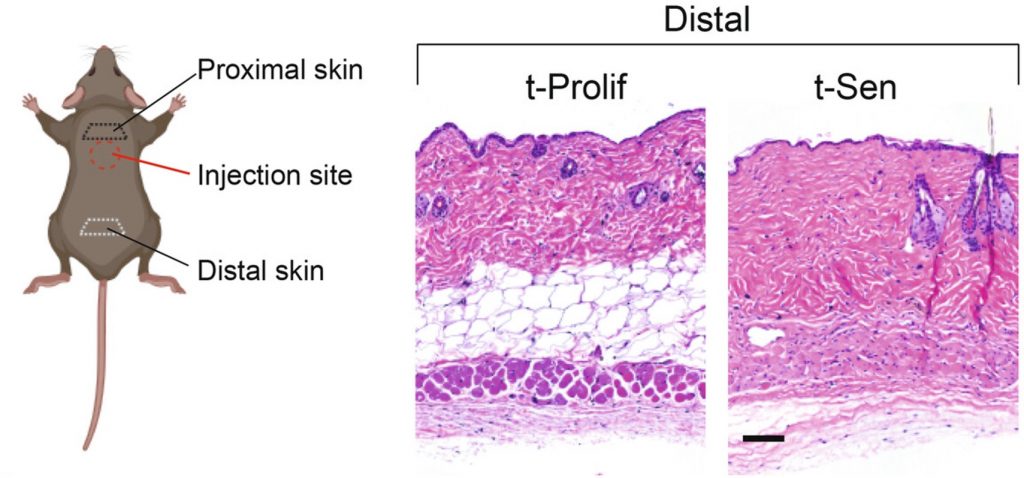Key Points:
- Senescent cells, cells that promote biological aging, can spread signs of aging (e.g., skin thinning) across the skin.
- Senescent cells in the skin also trigger signs of muscle and bone aging while worsening mobility and physical performance.
- Skin senescent cells spread aging to the brain, leading to memory loss but not anxiety.
Our heart pumps blood to every organ in our body via the circulatory system, which provides our cells with vital oxygen and nutrients. However, this system can also work against us by spreading age-promoting molecules. According to a new Mayo Clinic study, some of these molecules may even travel from the skin to the brain and trigger cognitive decline.
Age-Promoting Senescent Cells
In response to various stimuli, including ultraviolet radiation exposure, our skin cells can enter a senescent state. Upon entering senescence, senescent cells cease division and begin emitting various molecules with differing functions. These secreted molecules, collectively known as SASP (senescence-associated secretory phenotype) factors, can affect not only surrounding tissues but also distant ones via the circulatory system. Among the SASP factors, some induce senescence in other cells while others promote tissue deterioration, the basis of aging.
Senescent Cells Spread Aging Across the Skin
To determine if senescent cells in one area of the skin can affect distant areas of the skin in mice, Mayo Clinic researchers transplanted senescent cells near the neck. After five months, the researchers found that the senescent cells provoked skin thinning, a sign of skin aging, as measured by a reduction in the fat layer beneath the top layer. Not only did this occur close to the site of transplantation near the neck but also in a distant area near the rear of the mouse. The findings demonstrate that senescent cells can affect distant areas of the same organ.

Senescence Spreads to Muscle, Bone, and Brain
After finding that senescence can spread across the skin, the Mayo Clinic researchers examined the muscle and bone of the same mice. They found that senescent cells in the skin elevated the occurrence of muscle cells with central nuclei, a sign of muscle aging. Additionally, the bones of the senescent cell transplanted mice were less dense, an indicator of bone loss and skeleton aging. Furthermore, the mice had worse balance and a weaker grip. The findings demonstrate that senescent cells in the skin can spread aging to other organs and lead to decrements in mobility and physical performance.
The researchers also tested whether senescent cells planted in the skin could affect brain aging by measuring both anxiety-like behavior and memory. While the mice transplanted with senescent cells did not exhibit heightened anxiety, they exhibited poor memory, a sign of cognitive decline. Importantly, increased SASP factors were detected in the brain, muscle, and skin. Together, these findings suggest that senescent cells in the skin can spread aging to multiple organs via the SASP factors they secrete.
How to Slow Aging by Getting Rid of Senescent Cells
Senolytics are compounds that selectively eliminate senescent cells and are associated with mitigating age-related diseases and extending the lifespan of animal models. Senolytics are one of the most researched and sought after anti-aging compounds in the biological aging field and community. Mayo Clinic researchers have previously suggested that the combination of senolytics and NAD+ precursors — another class of promising anti-aging compounds — can work together to deter aging. Some nutraceuticals, such as RESTORIN, already contain this combination. Such combinatorial nutraceuticals may potentially counteract biological aging by targeting senescent cells and age-related NAD+ decline.